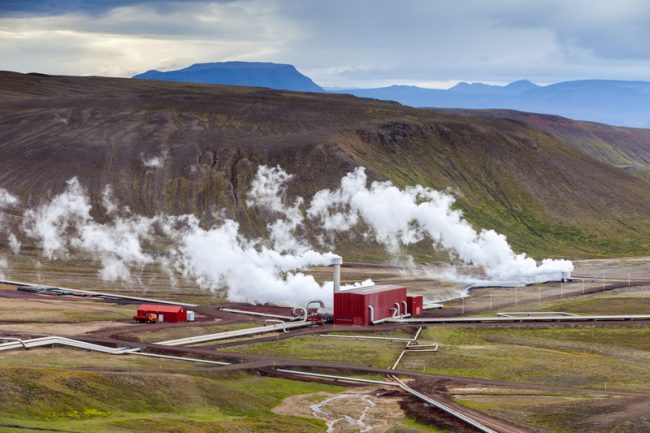A new project in Iceland is aiming to drill directly down to magma, or molten rock, in the Earth's crust. The goal is to discover a more powerful source of renewable geothermal energy (we'll get to that, promise). If it is successful, the Iceland Deep Drilling Project (IDDP) will be the hottest power source of its kind in the world. Iceland is a perfect place for a breakthrough like this because it is a volcanic island. Its Krafla geothermal field, or plant, already generates a large amount of the country's power.
The drilling for the IDDP began in mid-August in Reykjanes in the southwest of the country. It aims to drill a well, or hole, 5 kilometres (3 miles) deep.
Heat from the Earth
People bathe in a hot spring in Iceland. This hot spring also powers a geothermal plant that you can see in the background. (Getty Embed)
Geothermal power is a technique that uses the Earth's natural interior heat as a source of energy. Down under the crust, there are places where magma flows relatively close to the surface (magma is what bursts up through volcanoes as lava). These rivers, or veins, of magma are super hot. When magma is close to the surface, it heats up the rocks directly above it, as well as any bodies of water close by. This can lead to hot springs.
A hot spring is a naturally heated pool of water that can be as warm and soothing as a hot tub... or much, much hotter than that. When this water is heated, it evaporates and turns into steam. Steam is what geothermal plants are after. Sometimes, they use the hot springs at the surface to get steam. But to find even more powerful sources, they drill a well.
Well, well, well... that's hot stuff!
Steam rises from the Krafla geothermal field in Iceland. (Getty Embed)
A geothermal well is dug to reach super hot rocks under the surface. Cold water is then pumped into these wells, where it gets heated and turns into steam. As this steam rises, it turns turbines, which is then turned into energy. This idea is not all that different than the techniques used to power steam locomotives, except these turbines are much larger and generate a lot more power.
Traditionally, a geothermal well is dug to reach rocks that are heated by magma underneath them. But the IDDP is aiming to reach the actual magma. This means that the temperatures will be much higher, somewhere between 400 and 1000 °C (750 to 1830 °F). This super hot temperature also means that far more energy will be released. The average geothermal well can release 5 megawatts of power. This one could release up to 50 megawatts!
See you in December
Of course, this is all maybes at this point. Krafla struck magma in 2009, but was only able to test the use of magma directly for power. It couldn't use it regularly. But if this new project is successful, it could change renewable energy, both in Iceland and in other places with magma relatively near to the surface.
 The Krafla geothermal plant in Iceland. This new project aims to find energy that is up to ten times more powerful than what is found here. (© Selitbul | Dreamstime.com)
The Krafla geothermal plant in Iceland. This new project aims to find energy that is up to ten times more powerful than what is found here. (© Selitbul | Dreamstime.com)










That’s a great way to make energy
Sounds like a great project,look where the steam locomotive took us.